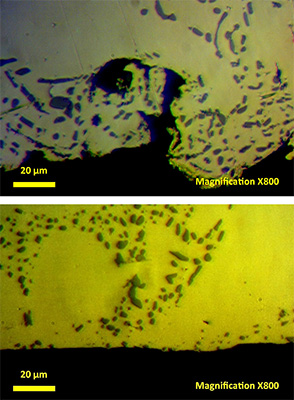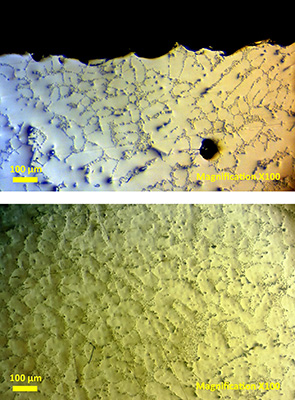An Australian test of counterfeit alloy wheels has exposed potentially lethal manufacturing flaws which could cause them to crack and fail in normal driving conditions.
The tests have revealed significant defects in the form of pores and cavities that can be seen with the naked eye.
Laboratory testing of the fake imports was a follow-up to a dynamic evaluation commissioned by the Federal Chamber of Automotive Industries at GM Holden’s proving ground in an industry-standard ‘pothole impact test’ using Mercedes-Benz alloy wheels as a benchmark.
At just 50km/h – a common speed in much of urban Australia – the fake wheels shattered while the genuine, original equipment wheel easily withstood the impact.
The follow-up laboratory testing and analysis has now identified faults in the manufacturing process as the likely cause of the failure.
Mark Skaife, champion racing driver and ambassador for the FCAI’s Genuine Is Best initiative, said: “The genuine and counterfeit wheels look similar but these tests have proven the potentially lethal consequences of making the wrong choice.
“The fake wheels were sourced from an Australian-based online store, and at first glance you might think you’re getting a great deal. But the major concern with fakes is safety, and using them, knowingly or otherwise, means you’re taking a huge risk,” Skaife said.
“The way to avoid safety concerns posed by fakes is to ensure you or your repairer source genuine parts from the vehicle maker’s authorised supply chain. For safety’s sake, Genuine Is Best,” he said.


Seven laboratory tests
To understand how and why alloy wheels that look virtually identical delivered such dramatically different results, Genuine Is Best enlisted the help of the Laboratories for Materials Advanced Testing Services (LMATS), a specialist team of highly qualified and independently accredited* metallurgists, engineers and inspectors.
The genuine and fake wheels were subjected to a regime of seven tests: chemical and radiographic analysis, penetrant, tensile, hardness and impact testing, plus metallographic (microstructure) assessment.
The headline results were significant defects in the fake wheel, including micro and macro porosity, as well as hot tearing (cracks on the surface, sub-surface and inside the casting), determined to be caused by poor quality casting and manufacturing processes.
It is considered that gaseous porosity in the alloy is generally caused by poor manufacturing conditions where the molten metal may be overheated during the casting process.
Volatility due to high heat allows the aluminium to absorb gas, most often hydrogen in the form of humidity or residual moisture in the mould, which sets as bubbles after the casting solidifies.
According to LMATS materials engineer Yashwin Mahadea, dye penetrant and metallographic testing clearly identified major flaws in the fake wheel’s structure.
“Radiographic analysis on the counterfeit rim revealed the presence of large pores and cavities in the centre wheel and spoke area,” Mr Mahadea said.
“Dye penetrant testing also identified multiple areas of severe porosity in the counterfeit wheel, while no recordable faults were observed on the genuine wheel in either test,” he said.
Microstructure assessment looked at samples taken from the spoke section of each wheel at 100, 400 and 800-times magnification.
It confirmed hot tearing in the counterfeit wheel which is considered a result of stresses building up towards the end of solidification in the casting process, while no defects were observed in the genuine wheel.




About Genuine Is Best
The FCAI’s Genuine Is Best initiative focuses on the safety, performance and durability benefits delivered by genuine replacement parts.
Genuine parts are made or selected by the vehicle’s maker and rigorously tested by that maker as an integral component of the vehicle to meet high quality, safety and performance standards.
This ensures a vehicle will drive, function and protect in the way it was intended.
If a vehicle needs replacement parts following a collision or during servicing and maintenance, it is essential that genuine parts are fitted.
Genuine parts are new and the only parts approved and warranted by the vehicle’s maker.
You can only guarantee supply of genuine parts by sourcing them through the vehicle maker’s authorised supply chain. Use anything else and you may be taking a risk.
Find out more at https://genuineisbest.com.au/.